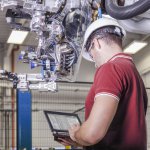
DHL is betting on digital twins to help further optimize operations. Source: Shutterstock
DHL believes digital twins will revolutionize logistics operations
ALTHOUGH many organizations are still getting to grips with data and analytics, the reality is that pioneers of technological innovation in business operations have moved on to creating digital twins to transform their business.
First spoken of by companies such as Rolls Royce and GE more than two years ago, digital twins now becoming more accessible as specialists demonstrate its use cases in various industries.
Digital twins are essentially digital representations of “connected” physical assets created by leveraging real-time data, analytics, and visualization, and so on.
To truly make the most of a digital twin, companies often leverage artificial intelligence as well, making this something that organizations serious about climbing the digitally mature typically explore.
Recently, logistics giant DHL, a company that has been ahead of the curve with electric vehicles and exploring subterranean mobility options and autonomous vehicles, released a new report that emphasized how crucial digital twins will be to optimizing logistics operations.
Given their track record, it’s definitely something that has been in the labs for DHL for a long time now, and it seems as though the company is nudging its partners and competitors into action as industry-wide adoption means access to more robust data for everyone.
One of the important aspects of digital twins that the report emphasizes is the use of APIs and open standards, which again, provides insights into DHL’s long-term vision for how the technology can help the industry as well as provide better support to businesses and customers.
“Digital twins offer unparalleled capabilities to track, monitor, and diagnose assets,” said DHL Global Head of Innovation & Commercial Development and Senior VP Matthias Heutger.
“They will change traditional supply chains, with a range of options to facilitate data-driven decision making and collaboration, streamlined business processes, and new business models. We are keen to work with our customers and partners to jointly explore applications in our industry.”
What can digital twins do for the logistics industry?
DHL believes that digital twins could find a variety of applications in the logistics industry across the value chain, including container fleet management, shipment monitoring, and even in the field of logistics systems design.
IoT sensors on individual containers, for example, show their location and monitor for damage or contamination. This data flows into a digital twin of the container network, which uses machine learning to ensure that containers are being deployed as efficiently as possible.
Digital twins can be applied not only for individual assets but entire networks and ecosystems such as warehouses, combining a 3D model of a facility with inventory and operational data.
The system can, therefore, provide an overview of the state of machines and product availability and could make predictions and autonomous decisions about stock or deliveries.
The same principle applies to major logistics hubs or global logistics networks, DHL points out.
“Powered by IoT, cloud computing, artificial intelligence and advanced visualization tools, digital twins are becoming a more attractive and accessible option for companies,” said DHL Innovation and Trends Research VP Markus Kückelhaus.
“However, bringing these and other relevant technologies together into a full digital twin implementation is a complex and challenging task. Close collaboration between all partners along the value chain is therefore essential to fully capture the potential.”
Is the investment in digital twins really warranted?
Digital twins require that companies bring together big data, AI, cloud, analytics and visualization, IoT, APIs, and other technologies just to get started with a project.
It’s not just a great investment of time and resources but also means preparing to disrupt business operations to incorporate a more data-driven approach across the length and breadth of the organization.
However, now is the time to get started for those in the logistics industry if it intends to continue to support and benefit from the growth in e-commerce in Asia and around the world.
Companies like Amazon and Alibaba are investing in and developing their own logistics companies or divisions to avoid relying on traditional logistics partners.
Most recently, Amazon severed ties with FedEx as an existing contract for express shipping came to an end last month.
The e-commerce giant announced at the end of last year that it’ll be expanding its fleet of cargo aircraft to 50, taking away more control from partners it relied on for more than a decade.
Tech Wire Asia recently spoke to Alibaba’s logistics arm Cainiao Network CTO Xuemei Gu who is also exploring the amplify its efficiencies in the near future, with technologies similar to those that a digital twin leverages.
“We expect to build a smart logistics network in China which will help reduce the cost of logistics as a percentage of China’s GDP to below 5 percent. We’ve also already launched an IoT open platform for partners and peers in the industry to help reduce hardware costs to one-tenth of the original,” said Gu.
As logistics companies, especially those that are more traditional and rely solely on basic computer systems and software, move into the digital era, a shift in mindset is critical if they intend to survive.
To thrive in the future, however, as DHL’s report points out, investments in digital twins might prove necessary.
READ MORE
- Strategies for Democratizing GenAI
- The criticality of endpoint management in cybersecurity and operations
- Ethical AI: The renewed importance of safeguarding data and customer privacy in Generative AI applications
- How Japan balances AI-driven opportunities with cybersecurity needs
- Deploying SASE: Benchmarking your approach








